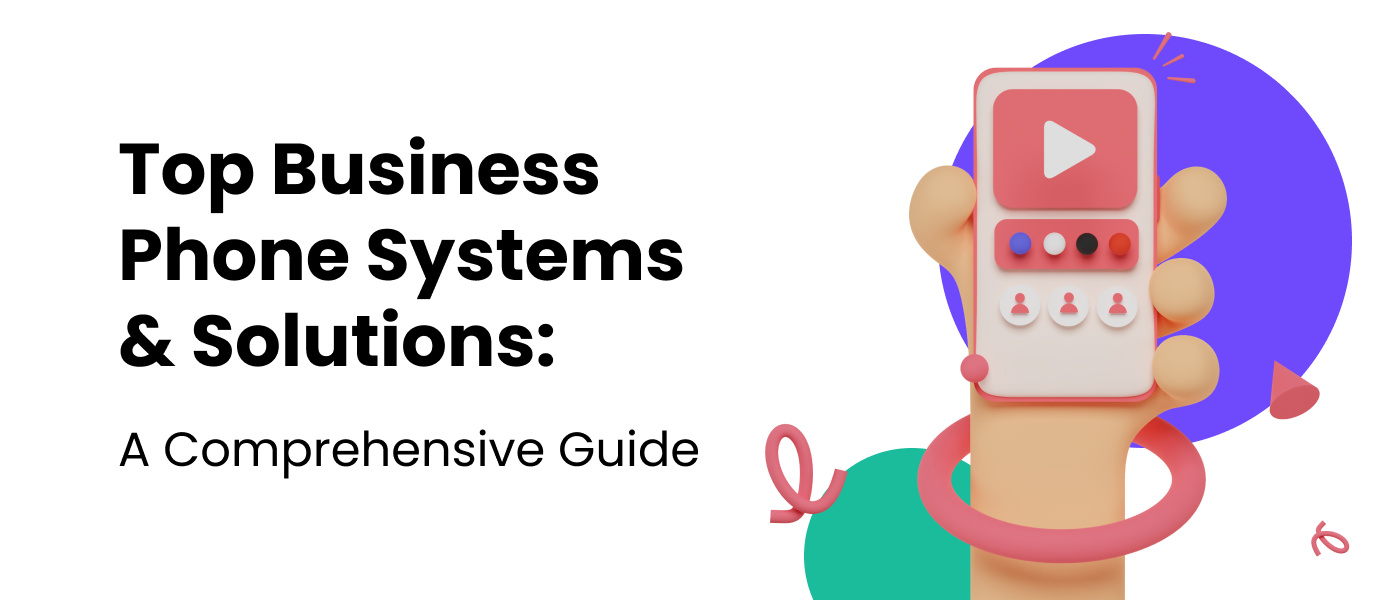Are you tired of endless phone tag and frustrating communication breakdowns? In modern business, streamlined communication is simply non-negotiable. The right business phone system can significantly improve your communication efficiency, enhance customer service, and boost operational productivity across various departments. In this guide, we’ll explore the world of business phone systems, key features, and top solutions on the market. Keep reading to find the perfect phone system for your unique needs.
What Are Business Phone Systems?
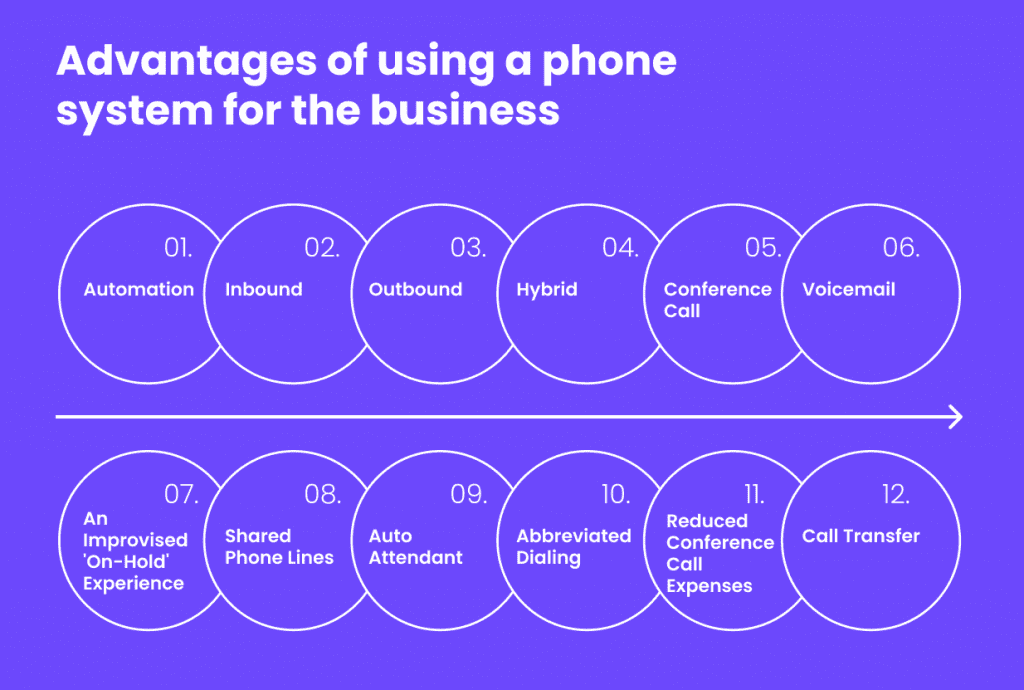
Business phone systems go beyond traditional phone lines, offering a range of advanced features specifically designed to streamline communication within your organization and elevate your interactions with clients and partners. These systems can be on-premise, cloud-based, or a hybrid of both, and offer functionalities like:
- Multiple phone lines: Handle a high volume of calls simultaneously, ensuring everyone who reaches your business gets connected.
- Auto attendants: Greet callers with a professional message, route them to the appropriate department, and eliminate the need for constant manual call answering.
- Voicemail to email transcription: Never miss a message — receive voicemail transcripts directly in your inbox for easy access and follow-up.
- Call forwarding: Forward calls to mobile or other designated numbers to ensure they reach the right person, even when they’re on the move.
- Call conferencing: Easily host productive meetings with multiple participants, both internal and external.
Why Your Business Needs a Robust Phone System
Investing in a powerful business phone system can unlock numerous benefits for your organization, including:
- Enhanced Customer Service: Deliver exceptional customer experiences with features like auto attendants, call routing, and voicemail transcription, ensuring prompt responses and efficient call handling for calls directed to your dedicated business phone number.
- Increased Productivity: Streamline workflows and empower employees to focus on core tasks. Features like call forwarding, business voicemail services, and conferencing eliminate time spent managing calls and improve overall efficiency.
- Improved Collaboration: Foster seamless communication and teamwork within your team. Internal extensions, conferencing options, and instant messaging tools help enhance effortless collaboration on projects and tasks.
- Scalability: Choose a system that grows with your business. Cloud-based solutions offer flexible scalability to accommodate expanding teams with evolving needs.
- Cost Savings: Reduce reliance on traditional phone lines and potentially save on long-distance call charges. Many cloud-based systems offer predictable monthly fees, simplifying budgeting.
- Professional Image: Project a professional image with a reliable and feature-rich phone system. Crystal clear call quality and advanced features like call forwarding services and voicemail greetings demonstrate your commitment to excellent communication.
Types of Business Phone Systems
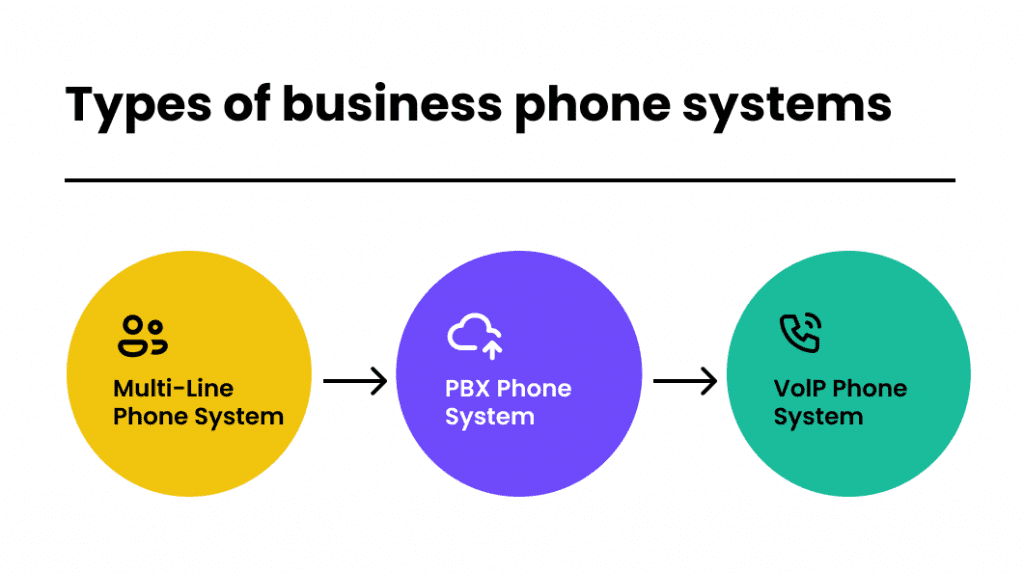
Over the last 20 years, phone systems have evolved significantly beyond traditional landlines. Today, businesses have a variety of options to choose from, including cutting-edge systems that leverage AI. These innovative solutions offer distinct advantages and cater to different needs and budgets. Understanding the core functionalities of each type, including AI phone systems, will empower you to make an informed decision and select the system that best aligns with your communication requirements.
VoIP (Voice over Internet Protocol)
VoIP, or Voice over Internet Protocol, revolutionized business communication by enabling voice calls to be transmitted over a broadband internet connection instead of traditional phone lines. This technology offers a multitude of benefits for businesses, such as:
- Cost-Effectiveness: VoIP calls often come at significantly lower rates compared to traditional landlines, especially for long-distance calls.
- Scalability: VoIP systems are inherently scalable, making it easy to add or remove users as your business grows. There’s no need for additional phone lines, as the system uses your existing internet bandwidth.
- Flexibility: VoIP allows for remote work arrangements, as employees can use their business phone number from any location with a high-speed internet connection.
- Advanced Features: VoIP systems often come with advanced features like call forwarding, voicemail to email, auto attendant, call recording, and conferencing capabilities, enhancing communication efficiency.
- Integration Potential: Many VoIP solutions easily integrate with business productivity tools like CRM platforms and collaboration software. This streamlines workflows and improves overall communication effectiveness.
However, there are also some considerations to keep in mind with VoIP systems:
- Internet Reliance: VoIP systems rely heavily on a stable and reliable internet connection. Quality of service (QoS) is crucial for crystal clear call quality. Businesses with unreliable internet connections might experience call drops or poor audio quality.
- Security Concerns: As VoIP transmits voice data over the internet, security considerations become increasingly important. Choose a VoIP provider that prioritizes secure data encryption and adheres to industry best practices.
PBX (Private Branch Exchange)
PBX, or Private Branch Exchange, is a traditional on-premise business phone system offering a range of advanced features and call management capabilities. A PBX system acts as a central hub for all your business phone lines, allowing internal calls to be routed efficiently without incurring external phone charges. It also provides features like voicemail, auto attendant, call forwarding, and conferencing.
Here are some of the main advantages of PBX systems:
- Advanced Features: PBX systems typically offer a wider range of advanced features compared to basic VoIP systems. This might include features like call queuing, skills-based routing, call recording with detailed analytics, and integration with legacy phone systems.
- Customization: On-premise PBX systems offer a high degree of customization, allowing businesses to tailor the system to meet their specific needs and call routing requirements. This can be particularly beneficial for businesses with complex call-handling processes.
- Security and Control: PBX systems offer a greater degree of control over data security, as all hardware and software components reside on-premise.
However, PBX systems also come with some drawbacks:
- Upfront Costs: Implementing a PBX system can involve significant upfront costs for hardware, software licensing, and installation.
- Maintenance and Support: Businesses are responsible for ongoing maintenance and technical support for their PBX system, which requires IT expertise or outsourcing to a third party.
- Scalability: Scaling a traditional PBX system can be complex and expensive, as additional hardware could be needed to accommodate growth.
Cloud-based Systems
Cloud-based business phone systems, also known as Hosted PBX, have come about as a popular choice for businesses of all sizes. These systems leverage the power of cloud computing, eliminating the need for on-premise hardware and software. Businesses simply subscribe to a cloud-based service, and all the necessary infrastructure is hosted by the provider.
Here are some of the key benefits of cloud-based phone systems:
- Cost-Effectiveness: Cloud phone systems typically have a lower upfront investment compared to traditional PBX systems. Businesses pay a monthly subscription fee based on the number of users and features needed, making them a budget-friendly option for startups and small businesses.
- Scalability: Cloud-based systems are inherently scalable. Adding or removing users is a simple process, allowing your phone system to grow along with your business without additional hardware investments.
- Ease of Use: Cloud-based systems are generally user-friendly and require minimal IT expertise. Features are readily accessible through an intuitive web interface or mobile app, eliminating the need for complex configuration.
- Automatic Updates: The provider handles all software updates and maintenance, ensuring your system is always up-to-date with the latest features and security patches. This frees up your IT resources to focus on other core business functions.
- Mobility and Remote Work: Cloud-based systems empower a mobile workforce. Employees can use their business phone number app and access features like voicemail and call forwarding from any location with an internet connection, fostering flexibility and productivity for remote teams.
Considerations for Cloud-based Systems:
- Internet Reliance: Similar to VoIP systems, cloud-based phone systems rely on a stable and reliable internet connection. Businesses with inconsistent internet connectivity might experience call quality issues.
- Vendor Lock-in: While some cloud providers offer open-SIP architecture, allowing integration with various devices, others might have proprietary systems. It’s important to evaluate the level of vendor lock-in before choosing a cloud-based solution.
Hybrid Solutions
Hybrid business phone systems combine elements of both on-premise PBX systems and cloud-based solutions. This approach can be ideal for businesses with existing legacy phone infrastructure or those with specific call routing needs that require some on-premise control.
Here are some benefits of hybrid solutions:
- Flexibility: Hybrid systems offer a blend of on-premise control and cloud-based scalability, allowing businesses to tailor the solution to their specific requirements. Existing PBX systems can be integrated with cloud services for features like remote work capabilities or advanced call analytics.
- Cost Optimization: By using existing PBX infrastructure, hybrid solutions can help businesses avoid the full upfront cost of a complete cloud-based system. They can gradually migrate functionalities to the cloud as needed.
- Phased Migration: As mentioned above, hybrid solutions offer a smooth path for businesses transitioning from traditional PBX systems to a cloud-based future. Features and functionalities can be migrated to the cloud at a controlled pace, minimizing disruption and ensuring an easy transition.
Considerations for Hybrid Solutions:
- Complexity: Managing a hybrid system can be more complicated compared to a purely cloud-based or on-premise solution. IT expertise might be needed to maintain both the on-premise hardware and the cloud components.
- Integration Challenges: Ensuring seamless integration between on-premise PBX and cloud services can require some technical expertise. Compatibility and interoperability between different systems need to be carefully considered before committing to anything.

Key Features to Look for in a Business Phone System

Choosing the right business phone system requires consideration of the essential features and add-ons that best suit your business’s needs.
Essential Features:
- Multiple phone lines: Accommodate a high call volume and ensure all calls are answered quickly.
- Auto attendant: Free yourself from the limitations of traditional answering services for small businesses. A professional auto attendant greets callers, efficiently routes them, and minimizes the need for manual call answering, providing a cost-effective solution compared to outsourced services.
- Call forwarding: Ensure calls reach the right person, even when they’re unavailable at their desk.
- Voicemail to email transcription: Receive voicemail transcripts directly in your inbox for easy access and follow-up.
- Call conferencing: Host productive meetings with multiple participants, both internal and external.
- Call recording: Record calls for training, quality assurance, or dispute resolution purposes.
- Security: Choose a system that offers good security features to protect your sensitive business communications.
Advanced Features:
- Call analytics: Gain valuable insights into call patterns, identify trends, and optimize your communication strategy.
- CRM integration, including seamless Bullhorn integration: Integrate your phone system with your CRM platform for a unified workflow.
- Softphone functionality: Use your computer or mobile device as a business phone with softphone functionality, offering greater flexibility and remote work options.
- International calling: Make and receive international calls with ease and desirably at competitive rates.
- Customizable greetings: Personalize greetings for different departments or business hours to enhance the caller experience.
- Call notes: Take notes directly within the CRM as you chat, automatically logging details for easy reference and improved follow-up.
- Click-to-call: Save time with click-to-call functionality. Simply click a phone number within your CRM, and your call instantly connects.
- Disconnect: Sometimes, calls head south. With a single click, you can politely end the call for everyone on the line, maintaining professionalism and control.
- Local presence: Use local presence to display a familiar number when calling clients, improving your pick-up rates by over 200%.
- Monitoring: Discreetly listen in to your agents’ conversations for the purposes of providing valuable feedback and fostering a supportive learning environment.
- Screen pops: Identify incoming calls with a handy on-screen notification that displays the caller’s information and instantly links to their CRM record, allowing for personalized greetings and faster resolution.
- Whisper: Need to offer support? Whisper helpful information to your agent without the caller hearing, ensuring a smooth and productive conversation.

Top 13 Business Phone Systems & Solutions
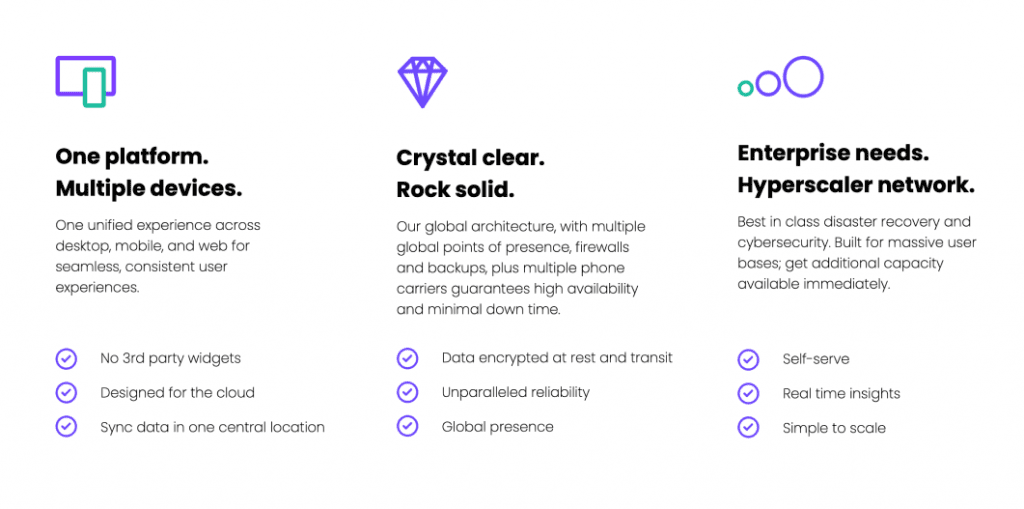
Here’s a breakdown of the top 13 cloud-based phone systems currently on the market, each full of features that will help streamline your workflows and impress your customers. We’ll compare their functionalities and see how they measure up against CloudCall.
CloudCall
Key Features:
- Cloud-based, easy to set up and use.
- Feature-rich with call routing, auto attendant, voicemail to email, call recording, and integrations with popular CRMs.
- Scalable to accommodate businesses of all sizes.
- Cost-effective with a transparent pricing structure.
- Mobile app for business calls and messaging on the go.
Pros:
- User-friendly interface.
- Excellent customer support.
- Strong focus on CRM integrations.
- Ideal for businesses that prioritize mobility and scalability.
Cons:
- Targeted Feature Set: CloudCall prioritizes a streamlined feature set designed to simplify communication workflows. While this is great for many businesses, some users who require highly specialized call center functionalities might need to explore alternative options.
CloudCall excels in:
- CRM integration: CloudCall offers seamless integrations with popular CRM platforms, streamlining workflows for sales, recruitment, and customer service teams.
- Ease of use: The intuitive interface makes CloudCall a user-friendly choice for businesses of all technical skill levels.
- Scalability and affordability: CloudCall’s cloud-based nature allows for easy scaling as your business grows, and the transparent pricing structure makes it a cost-effective option.
RingCentral
Key Features:
- A cloud-based system with a wide range of features, including video conferencing, call analytics, and integrations with popular CRMs.
Pros:
- A powerful feature set with video conferencing and call analytics.
- Strong international calling capabilities.
Cons:
- Pricing can be complex for larger businesses with many users.
- Some users report a less intuitive interface compared to CloudCall.
Comparison to CloudCall:
- Features: RingCentral offers a wider range of features. However, CloudCall is sufficient for many businesses and offers a more user-friendly interface.
- Pricing: CloudCall’s pricing is generally considered more transparent and potentially more cost-effective for smaller teams.
- CRM Integration: Both CloudCall and RingCentral integrate with popular CRMs, but CloudCall’s focus on this might be beneficial for businesses prioritizing a smooth CRM workflow.
Dialpad
Key Features:
- A cloud-based system with a focus on ease of use and integrations with business productivity tools.
- Offers features like call recording, voicemail transcription, and call analytics.
- Integrates with popular CRMs, as well as productivity tools like Google Workspace and Microsoft 365.
Pros:
- User-friendly interface with a focus on ease of use.
- Strong integrations with productivity tools.
Cons:
- Limited call center features compared to some competitors.
- May not be as scalable for very large enterprises.
Comparison to CloudCall:
- Features: Both CloudCall and Dialpad offer similar core features and a focus on user-friendliness. CloudCall might be a better choice for businesses with a strong CRM focus, while Dialpad excels in productivity tool integrations.
- Scalability: CloudCall’s cloud-based architecture might offer better scalability for larger organizations compared to Dialpad.
Nextiva
Key Features:
- A cloud-based system with a comprehensive feature set, including call analytics, video conferencing, and international calling.
- Offers a variety of plans to cater to different business needs.
Pros:
- Large feature set.
- Multiple plan options for flexibility.
Cons:
- Pricing can be higher than some competitors for similar features.
- The interface might be less intuitive for non-technical users compared to CloudCall.
Comparison to CloudCall:
- Features: Nextiva offers a wider range of features, but CloudCall is sufficient for many businesses and is more cost-effective.
- Ease of Use: CloudCall’s interface is generally considered more user-friendly.
- CRM Integration: While Nextiva offers CRM integrations, CloudCall’s focus on this area might be more advantageous for businesses prioritizing a seamless CRM workflow.
AirCall
Key Features:
- A cloud-based system with a focus on international calling and integrations with popular business tools.
- Offers features like call recording, voicemail transcription, and international calling with competitive rates.
Pros:
- Excellent international calling features.
- Strong integrations with business tools like Slack and Salesforce.
Cons:
- Limited call center features.
- May not be the most scalable option for very large enterprises.
Comparison to CloudCall:
- Features: Both CloudCall and AirCall offer core features like call recording and voicemail transcription. CloudCall might be a better choice for businesses with a strong domestic focus and CRM prioritization, while AirCall excels in international calling and integrations with business communication tools.
Grasshopper
Key Features:
- A cloud-based system designed for small businesses and startups.
- Offers a user-friendly interface and essential features like call forwarding, voicemail, and auto attendant.
Pros:
- Very user-friendly interface.
- Affordable pricing for small teams.
Cons:
- Limited feature set compared to some competitors.
- May not be suitable for businesses with high call volumes or complex needs.
Comparison to CloudCall:
- Features: CloudCall offers a wider range of features, including CRM integrations and call analytics, which might be important for businesses that require more than the basic needs of a small team.
- Scalability: CloudCall can scale to accommodate growth, while Grasshopper might be limiting for businesses that rapidly expand.
8×8
Key Features:
- A cloud-based unified communications platform offering a comprehensive feature set, including video conferencing, call center features, and integrations with popular CRMs.
Pros:
- Robust feature set with call center capabilities.
- Strong security features.
Cons:
- Pricing can be complex for larger deployments.
- The interface is less intuitive than CloudCall’s.
Comparison to CloudCall:
- Features: 8×8 offers a wider range of features, however, CloudCall is sufficient for many businesses, offering a more user-friendly interface and more transparent pricing.
- CRM Integration: Both CloudCall and 8×8 integrate with CRMs, but CloudCall’s focus on this aspect is advantageous for businesses prioritizing a seamless CRM workflow.
Vonage Business
Key Features:
- A cloud-based system offering a variety of features, including call recording, voicemail transcription, and integrations with popular CRMs.
Pros:
- A well-known brand with reliable service.
- Integrates with a variety of business tools.
Cons:
- Pricing can be higher than some competitors for similar features.
- The interface is less intuitive for non-technical users compared to CloudCall.
Comparison to CloudCall:
- Features: CloudCall and Vonage Business offer similar core features. CloudCall might be a better choice for businesses with smaller teams, who are looking for a more user-friendly interface and transparent pricing.
Ooma Office
Key Features:
- A cloud-based system designed for small businesses.
- Offers essential features like call forwarding, voicemail, and auto attendant at an affordable price point.
Pros:
- Easy to set up and use.
- Competitive pricing for small businesses.
Cons:
- Limited feature set compared to some competitors.
- May not be suitable for businesses with high call volumes or complex needs.
Comparison to CloudCall:
- Features: CloudCall offers a wider range of features, including CRM integrations and call analytics, which are often important for businesses going beyond the basic needs of a small team.
- Scalability: CloudCall can scale to accommodate growth, while Ooma Office might be limiting for businesses that are rapidly expanding.
Zoom Phone
Key Features:
- Seamless integration with existing Zoom accounts, ideal for businesses already using Zoom for video conferencing.
- A cloud-based system offering features like call routing (including auto attendant and skills-based routing), voicemail transcription, call recording, and integrations with popular CRM platforms.
- User-friendly interface designed for ease of use.
Pros:
- Strong integration with Zoom video conferencing, facilitating unified communication.
- Ideal for remote and mobile workforces.
- A user-friendly interface simplifies setup and ongoing management.
Cons:
- Pricing can be higher compared to some competitors, including CloudCall.
- There are limited customization options for complex call routing needs.
Comparison to CloudCall:
- While Zoom Phone offers strong video conferencing integration, CloudCall might be a more cost-effective option and has a wider range of call routing options.
Mitel MiCloud Connect
Key Features:
- A strong cloud-based system with a comprehensive suite of features catering to businesses of all sizes.
- Well-suited for organizations requiring advanced call center functionalities.
- Offers features like call center ACD (Automatic Call Distribution), skills-based routing, call recording with analytics, auto attendant, and integrations with various CRM and business applications.
- Provides high uptime and powerful security standards.
Pros:
- Feature-rich, ideal for call centers and businesses with complex communication needs.
- A secure and reliable platform.
Cons:
- Can be more complex to set up and manage compared to user-friendly options like CloudCall.
- There is potentially a higher learning curve for users due to the wider range of features.
Comparison to CloudCall:
- Mitel MiCloud Connect offers advanced call center features that CloudCall might not. However, CloudCall’s simpler interface and focus on ease of use is likely to be preferable for businesses with less complex communication needs.
Microsoft Teams Phone
Key Features:
- Integrates seamlessly with the Microsoft Teams collaboration platform, offering a unified communication experience for businesses heavily reliant on Microsoft 365 tools.
- Includes features like voice calls, video conferencing, chat, and file sharing within a single platform.
- Offers call routing, auto attendant, and integrations with other Microsoft 365 apps.
- Provides a mobile app for on-the-go communication.
Pros:
- Tight integration with the Microsoft Teams ecosystem promotes collaboration and streamlines communication for existing users.
- User-friendly interface simplifies adoption for businesses familiar with Microsoft Teams.
Cons:
- Requires a Microsoft 365 subscription, potentially limiting its use for businesses not invested in the Microsoft ecosystem.
- Limited compatibility with non-Microsoft applications compared to CloudCall’s broader integration capabilities.
Comparison to CloudCall:
- Microsoft Teams Phone offers a unified experience within the Microsoft ecosystem. However, CloudCall provides more flexibility with integrations beyond Microsoft applications and might be a better choice for businesses with diverse software tools.
GoToConnect
Key Features:
- A cloud-based system known for its ease of use and scalability, making it a good fit for small and medium-sized businesses.
- Offers features like call routing, auto attendant, voicemail transcription, call recording, and integrations with popular CRM platforms and business applications.
- Provides a mobile app with functionalities like call forwarding and voicemail management.
Pros:
- The user-friendly interface simplifies setup, management, and ongoing use.
- Easy to scale as your business grows.
- Offers good value for the features provided.
Cons:
- Might lack some advanced features for larger businesses with complex call routing needs.
Comparison to CloudCall:
- GoToConnect and CloudCall share similarities in terms of user-friendliness and scalability. CloudCall might offer a slight edge with advanced features like call routing and integrations, depending on your specific needs.

How to Choose the Right Business Phone System
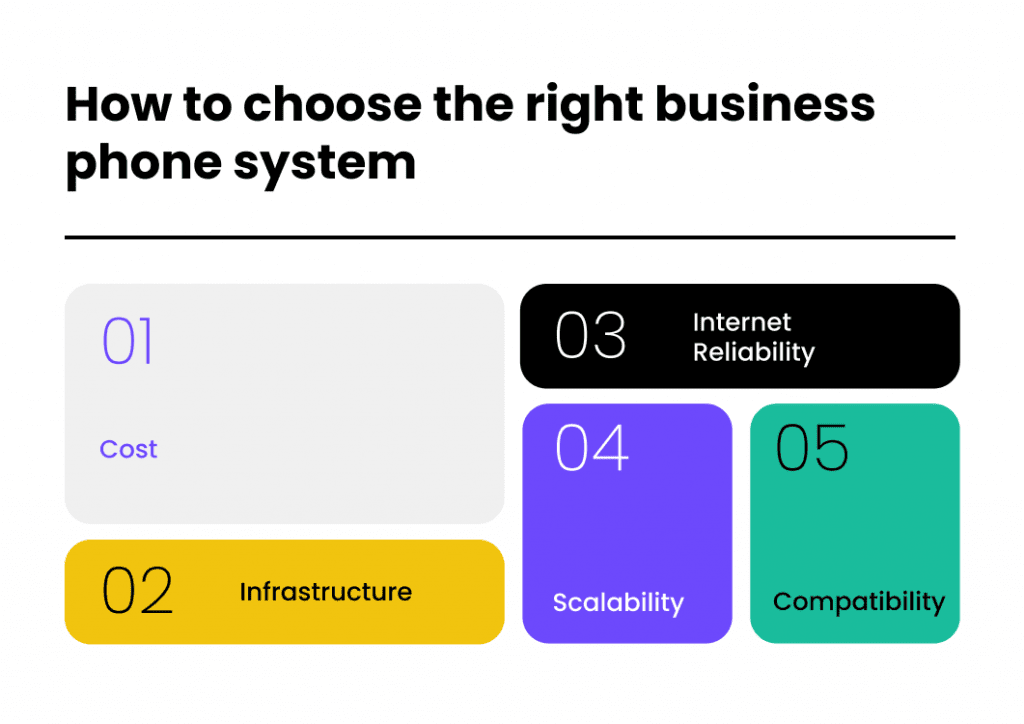
Selecting the right business phone system is a crucial decision that impacts communication efficiency, customer service, and overall business operations. With a vast array of options available, navigating the selection process can definitely feel overwhelming. Here’s a guide to help you choose the perfect business phone system for your unique needs:
Assessing Your Needs
The first step involves a thorough assessment of your current communication infrastructure and future growth aspirations. Here are some main factors to consider:
- Number of Users: Determine the number of employees who will be using the phone system. Consider any fluctuations or anticipated growth in your workforce.
- Call Volume: Analyze your typical call volume, including peak call times and average call duration. This will help determine the capacity and features required for smooth operation.
- Existing Infrastructure: Do you have existing PBX hardware or a legacy phone system? Evaluate if integration with your current setup is a priority for you.
- Features and Functionality: Identify the essential features you need, such as voicemail, call forwarding, auto attendant, conferencing, and call recording. Consider advanced features like CRM integration or skills-based call routing based on your specific requirements.
- Budget: Establish a realistic budget for your business phone system. Factor in upfront costs, ongoing monthly fees, and any potential maintenance or support charges.
- Security Requirements: Consider your industry’s compliance standards and data security needs. Choose a system with powerful security features and encryption protocols.
Comparing Options
Once you have a clear understanding of your requirements, start researching different business phone system providers and their offerings. Here’s how to effectively compare your options:
- Research Providers: Shortlist a few reputable business phone system providers with a solid track record and positive customer reviews.
- Compare Features and Pricing: Create a comparison chart highlighting the features, pricing plans, and user fees offered by each shortlisted provider. Prioritize features that are most important to your business.
- Read Reviews and Case Studies: Seek insights from existing customers through online reviews. This can reveal valuable real-world experiences and the potential benefits of different systems.
- Free Trials and Demos: Many providers offer free trials or demos to test their systems before committing. Take advantage of these opportunities to experience the user interface, test core functionalities, and assess if the system aligns with your needs.
Implementation and Training
After selecting the most suitable business phone system for your company, it’s time for smooth implementation and user training:
- Implementation Planning: Work closely with the chosen provider to develop a comprehensive implementation plan. This plan should outline the timeline, data migration process, and system configuration steps.
- Data Migration: If you are transitioning from an existing phone system, ensure a smooth data migration process to transfer call logs, voicemail messages, and contact information to the new system.
- User Training: Provide comprehensive training for your employees on the new system’s features and functionalities. Invest in user guides, video tutorials, or live training sessions to ensure everyone feels comfortable using the new system effectively.
- Technical Support: Familiarize yourself with the provider’s technical support options. Having access to reliable and responsive support is crucial for resolving any issues that might arise after implementation.

Benefits of a Modern Business Phone System

Investing in a modern business phone system can unlock a plethora of benefits for your business, including:
- Enhanced Customer Service: Deliver exceptional customer experiences with features like auto attendants, call routing, voicemail transcription, and call recording. These ensure prompt responses, efficient call handling, and improved customer satisfaction.
- Increased Productivity: Streamline workflows and empower employees to focus on core tasks. Features like call forwarding, voicemail, conferencing, and integrations with productivity tools can significantly improve overall efficiency.
- Improved Collaboration: Foster smooth communication and teamwork within your company. Internal extensions, conferencing options, instant messaging tools, and CRM integrations enable effortless collaboration on projects and tasks.
- Scalability: Choose a system that grows with your business. Cloud-based solutions offer flexible scalability to accommodate expanding teams and evolving needs.
- Cost Savings: Reduce reliance on traditional phone lines and potentially save on long-distance call charges. Many cloud-based systems offer predictable monthly fees, making budgeting simpler.
- Professional Image: Project a professional image with a reliable and feature-rich phone system. This will demonstrate your commitment to excellent communication.
- Security and Reliability: Modern business phone systems offer strong security features to protect your sensitive business communications.

Common Challenges and Solutions

Transitioning to a new business phone system can be an exciting time, but it’s normal to encounter some challenges along the way. Here, we’ll explore some of the most common hurdles you might face during implementation and provide effective solutions to overcome them:
1. User Adoption and Change Management
Challenge: Employees might be resistant to using a new system, especially if they are comfortable with the existing setup.
Solutions:
- Effective Communication: Clearly communicate the benefits of the new system to your team. Highlight features that will make their jobs easier and improve overall communication efficiency.
- Comprehensive Training: Provide thorough training on the new system’s functionalities. Offer user manuals, video tutorials, and live training sessions to ensure everyone feels comfortable using the new features.
- Employee Feedback: Encourage user feedback throughout the transition process. Address concerns promptly and provide ongoing support to build confidence in the new system.
2. Data Migration Challenges
Challenge: Moving existing call data, voicemail recordings, and contact information to the new system can be complicated.
Solutions:
- Partner with the Provider: Choose a business phone system provider with experience in data migration. They can handle the process efficiently and minimize disruption.
- Data Backups: Ensure you have secure backups of your existing data before the migration process begins. This acts as a safety net in case of any unforeseen issues.
- Data Verification: After the migration, verify the accuracy and completeness of the transferred data to ensure a smooth transition.
3. Downtime During Implementation
Challenge: There might be some downtime during the implementation process, which can disrupt ongoing business operations.
Solutions:
- Scheduling Disruption: Schedule the implementation process outside of peak business hours whenever possible. This helps minimize the impact on customer service and employee productivity.
- Clear Communication: Inform your team about any anticipated downtime and provide updates on the implementation process.
- Contingency Plans: Develop contingency plans for handling calls and customer interactions in case of unexpected downtime during the transition.
4. Addressing Technical Issues
Challenge: Even with the best planning, technical issues can arise after implementing a new system.
Solutions:
- Reliable Support: Choose a provider with a proven track record of reliable technical support. Ensure they offer 24/7 assistance with knowledgeable representatives who can help you resolve any technical challenges.
- User Troubleshooting Resources: Develop user guides and troubleshooting resources to help employees solve basic technical issues on their own.
- Regular System Updates: Stay up-to-date with the latest software updates and bug fixes offered by the provider.
5. Security Concerns
Challenge: Security breaches can pose significant risks to your business communication.
Solutions:
- Robust Security Features: Choose a business phone system with powerful security features like encryption protocols, user authentication, and access controls.
- Employee Training: Educate your employees about cybersecurity best practices, such as strong password management and an awareness of phishing attempts.
Future Trends in Business Phone Systems
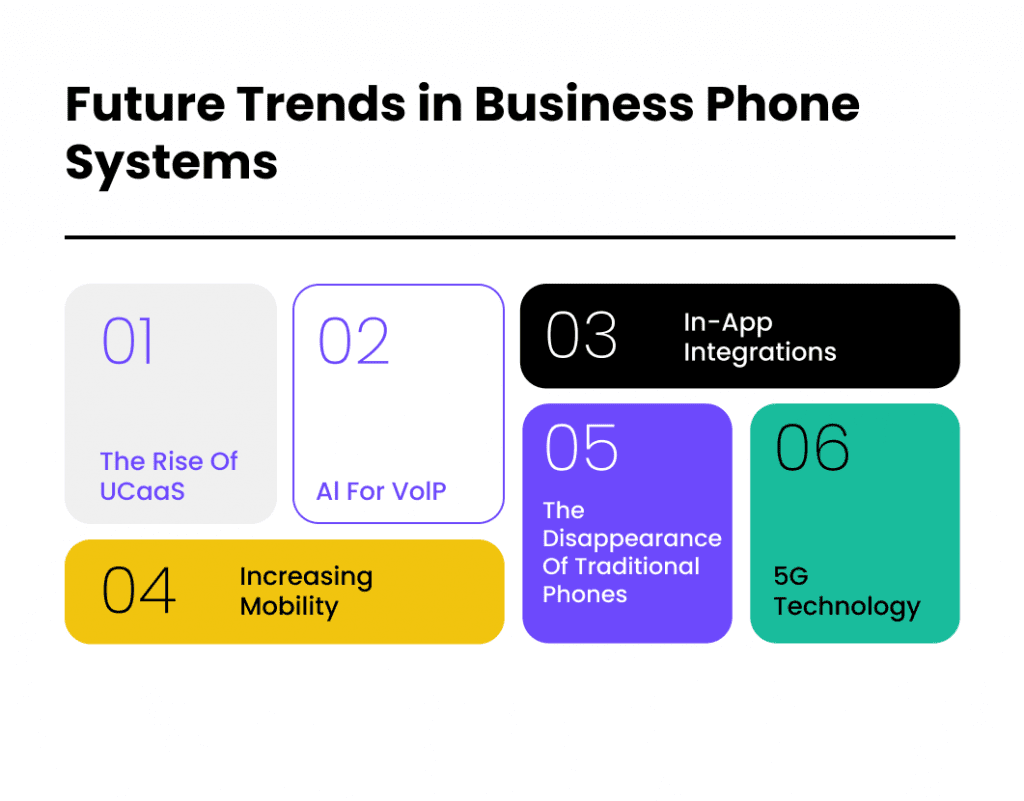
Business phone systems are constantly evolving. Here are some important trends to look out for:
- Artificial Intelligence (AI): AI can play a very prominent role in business phone systems, offering features like call transcription, sentiment analysis, and real-time coaching for customer service representatives.
- Integration with Collaboration Tools: The integration of business phone systems with collaboration tools like Slack and Microsoft Teams will become even more seamless than it is already, fostering unified communication and streamlined workflows.
- Increased Security Focus: With the growing importance of cybersecurity, business phone system providers will prioritize robust security features to protect sensitive communication data.
FAQ
Let’s get into some of the most frequently asked questions regarding business phone systems:
How can a new phone system support our international expansion efforts?
Many business phone systems offer features like competitive rates for international calling, international phone numbers, and the ability to manage calls from different locations. These features can streamline communication and support your international operations.
Can the system scale as we grow, and what are the associated costs?
Cloud-based business phone systems are typically designed to scale with your business. Many providers offer flexible plans that allow you to add or remove users as needed. Be sure to inquire about pricing structures and potential cost changes associated with scaling your service.
What features should I look for in a phone system to improve my sales team’s productivity?
Here are some key features that can significantly boost your sales team’s efforts:
- CRM Integration: Seamless integration with your CRM platform eliminates the need for manual data entry and significantly streamlines workflows. Features like click-to-call, screen pops with caller information, and call logging within the CRM can save time and improve the efficiency of sales calls.
- Call Recording: This allows for the analysis and review of sales calls to identify areas for improvement and coaching opportunities. Call recording can also be valuable for dispute resolution and compliance purposes.
- Call Analytics: Metrics like call duration, call abandonment rates, and peak call times all offer a chance for insights. This data can help you identify trends, optimize call routing strategies, and improve overall sales team performance.
- Voicemail Transcription: Salespeople no longer need to listen to lengthy voicemails. Voicemail transcription allows them to review messages quickly and prioritize follow-ups, saving valuable time.
- Mobility: Sales teams can stay connected and productive from anywhere with features like softphone functionality and mobile apps. This allows them to make and receive calls, access CRM data, and collaborate with colleagues on the go.
Are there integrations available with our CRM to streamline sales processes?
Yes, many cloud-based phone systems, including CloudCall, offer integrations with popular CRM platforms like Salesforce, HubSpot, and Zoho CRM. These integrations can seriously improve your sales efficiency by automating tasks, improving data flow, and providing valuable insights into your calls.
Look for features like:
- Automatic logging of calls and voicemails within your CRM for easy access and record-keeping.
- Click-to-dial functionality to easily initiate calls from your CRM contact records.
- Real-time call analytics to track call performance, identify areas for improvement, and gain valuable insights into customer interactions.
Are there integrations available with our ATS (Applicant Tracking System) for better candidate management?
Yes, some business phone systems offer integrations with Applicant Tracking Systems (ATS). This integration can automate tasks like sending interview invites or rejection notifications via phone call, saving recruiters time and streamlining the candidate management process.
What are the implementation timelines and potential downtime during the transition?
Implementation timelines for a new business phone system can vary depending on the complexity of your setup and the provider you choose. Generally, cloud-based systems can be implemented faster than on-premise solutions.
Most providers strive to minimize downtime during the transition. However, some downtime might be unavoidable. A reputable provider will have a proven track record of smooth transitions and will work closely with you to minimize any disruption to your business operations.
How user-friendly is the system for employees, and what training is required?
Most business phone systems are designed to be user-friendly and intuitive. However, some level of training is always recommended to ensure employees are comfortable using all the features and maximizing the system’s benefits.
The provider you choose should offer comprehensive training materials and support options to help your team get up and running quickly.
What kind of technical support and maintenance do you provide?
Reliable technical support is crucial for any business phone system. Look for a provider that offers 24/7 technical support with knowledgeable representatives who can assist you with any technical issues that may arise.
Maintenance for cloud-based systems is typically handled by the provider, ensuring your system is up-to-date and functioning optimally.
Get Started with a Top Businees Phone System
To sum up, choosing the right business phone system is an investment in the future of your communication infrastructure. By carefully assessing your needs, comparing different options, and considering the long-term benefits, you can find a solution that empowers your team, enhances customer service, and propels your business forward.

